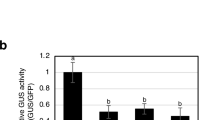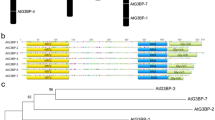Abstract.
In order to identify genes that are involved in the defense reaction against pathogen attack, we screened for examples that are regulated during the hypersensitive response (HR) to infection by tobacco mosaic virus (TMV) of tobacco (Nicotiana tabacum cv. Xanthi nc) carrying the N gene, which confers resistance to TMV. Among seven genes initially identified by fluorescent differential display, one clone was further characterized because its transcripts accumulated rapidly and transiently after the onset of HR. Its full-length cDNA of 1346 bp encoded a polypeptide consisting of 258 amino acids. The deduced protein contained a single WRKY domain, a Cys2His2 zinc-finger motif and a leucine-zipper motif, showing high similarity to WIZZ, a member of the family of WRKY transcription factors in tobacco. The gene was thus designated TIZZ. A GFP-TIZZ fusion protein was found to localize to the nucleus upon introduction into epidermal cells of onion. Bacterially expressed TIZZ was able to bind to the W-box (TTGAC) element that is recognized by other WRKY proteins, but transactivation assays showed it to be unable to activate reporter gene expression by itself. TIZZ transcripts were induced in TMV-infected nahG transgenic tobacco plants, in which salicylic acid fails to accumulate. Neither exogenously applied salicylic acid nor mechanical wounding induced TIZZ transcript accumulation. These results indicate the presence of salicylic acid-independent pathways for HR signal transduction, in which a novel type of WRKY protein(s) may play a critical role for the activation of defense.
Similar content being viewed by others
Author information
Authors and Affiliations
Additional information
Electronic Publication
Rights and permissions
About this article
Cite this article
Yoda, .H., Ogawa, .M., Yamaguchi, .Y. et al. Identification of early-responsive genes associated with the hypersensitive response to tobacco mosaic virus and characterization of a WRKY-type transcription factor in tobacco plants. Mol Gen Genomics 267, 154–161 (2002). https://doi.org/10.1007/s00438-002-0651-z
Received:
Accepted:
Issue Date:
DOI: https://doi.org/10.1007/s00438-002-0651-z




